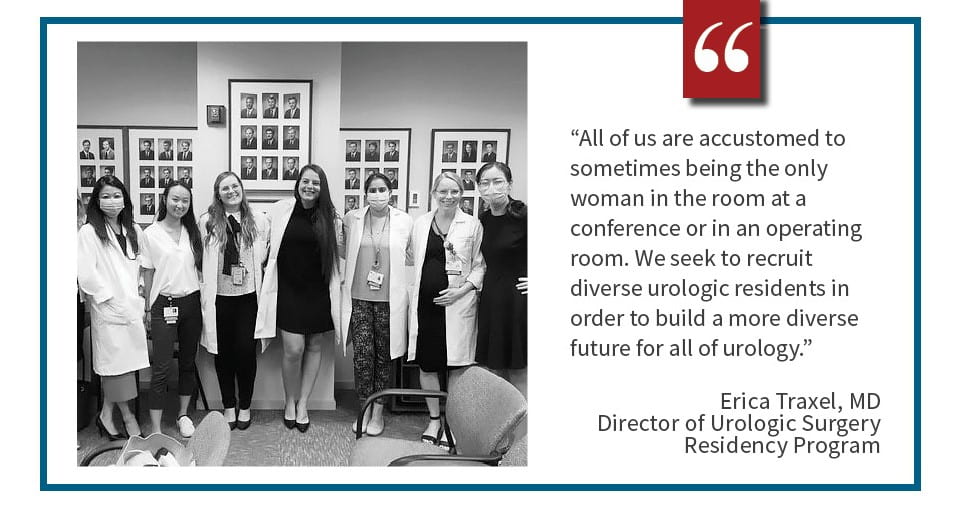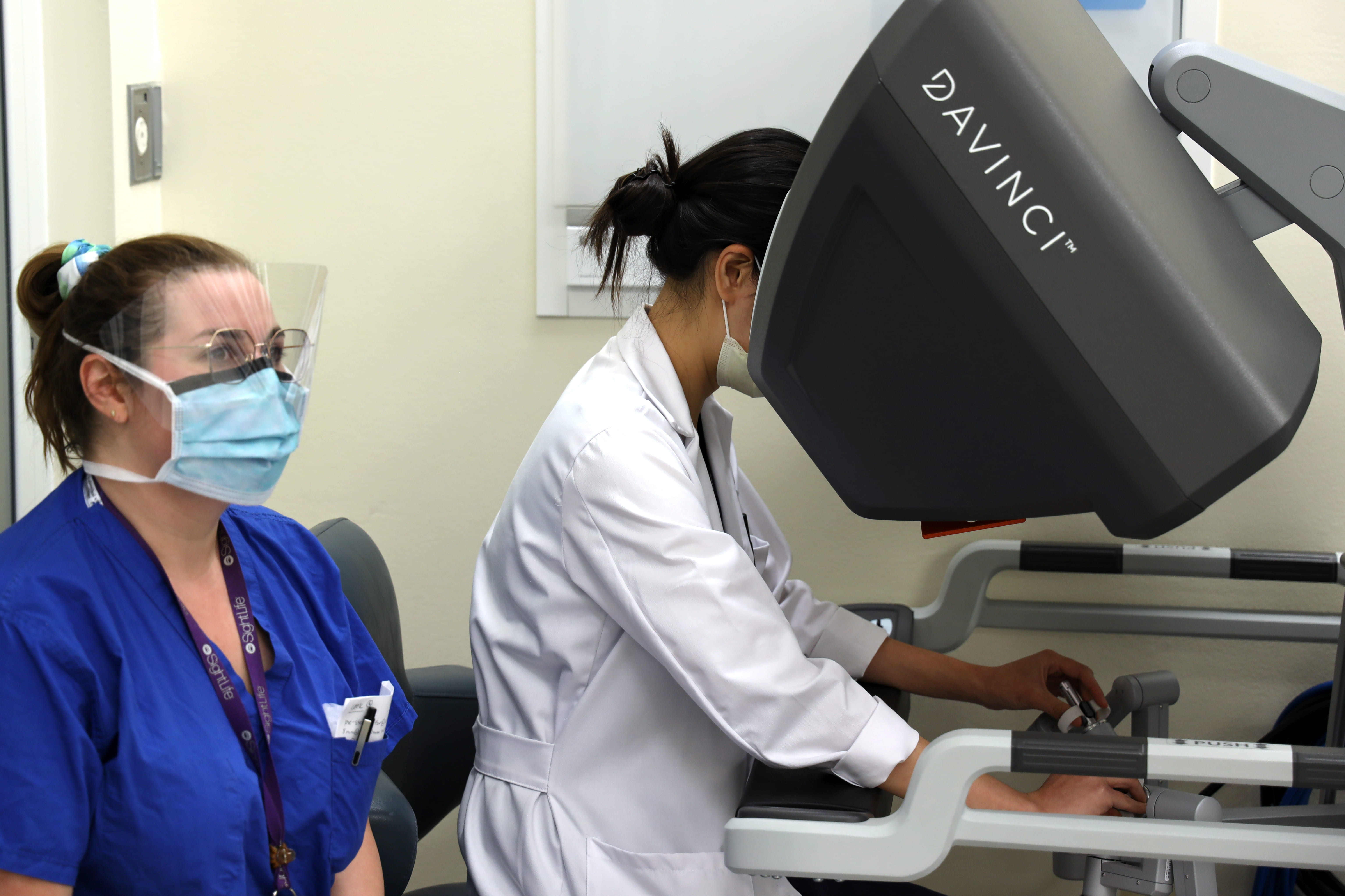
When Erica Traxel, MD, graduated from medical school, she knew she wanted to pursue a career in urology. Traxel was passionate about patient care, and knew that urology was the specialty where she could best help her patients with their health conditions. Like hundreds of graduating medical students each year, Traxel interviewed at several urology residency programs across the country, looking for the right fit. She was looking for a program that would give her high clinical case volume, the opportunity to treat a diverse patient population and experience with expert faculty. What Traxel did not realize until she started interviewing was that she was also looking for a program that had experience training women in urology—something she hadn’t expected would be difficult to find.
“I would go to interview for residency and they would say they had never had a woman resident before,” Traxel recalls. “I would think to myself, I don’t know that I want to be your guinea pig.”
Traxel, Assistant Professor of Urologic Surgery and Director of the Urologic Surgery Residency Program at Washington University School of Medicine in St. Louis, chose Washington University for her own residency, as the program fulfilled every personal requirement she had, including a history of training women to be excellent urologists.
Growing Opportunities
Research shows that the role of women in medicine—and specifically in urology—is growing. According to the Association of American Medical Colleges (AAMC), in 2019 females made up the majority of U.S. medical students (50.5%) for the first time.
More female medical students are applying to and matching into Urology now than in past years. In 2020, 122 of the 441 total applicants (28%) identified as female. Of the 83% of medical school graduates who successfully matched, 86% of females matched, while 77% of males matched.
Women applying for residency are matching despite additional obstacles their male counterparts do not face in the application process. A December 2019 study, published in Urology, evaluated letters of recommendation submitted for male and female urology applicants. The study found an implicit bias in the tone and language of these letters, with those written for male applicants more frequently referencing “personal drive, work, and power,” whereas letters written for female applicants were more likely to identify personal characteristics. Such unconscious bias among letter writers could influence the likelihood of women matching.
Despite this implicit bias, the match rate for females has increased from 68% in 2013 to 86% in 2020, marking the first year that the rate for females has exceeded the overall match rate. This suggests that residency programs are recognizing women as competitive and desirable applicants.
This is certainly true of the Urology Residency program at Washington University.
“One of the things that sets us apart is that we have a lot of residents who are women,” Traxel says. There are currently 18 residents in the program, 7 of which are women.
Female residents in the Urology Residency program choose urology for several different reasons, including the opportunity for multimodal therapy and for longitudinal patient care.

“I really liked operating, but I didn’t enjoy seeing a patient for only one visit,” says Carrie Ronstrom, MD, PGY-4 Urology Resident. “With urology, you’re able to meet the patient in clinic, try medical modalities first, and then you can progress to surgery if needed. I liked being able to establish that relationship with patients.”
Kathryn Agamawi, MD, PGY-3 Urology Resident, cites the breadth of surgical techniques used in urology as another factor that drew her to the program.
“I was interested in an operative field, and I think urology is attractive because it’s one of the only fields where you use all surgical modalities,” Agamawi asserts. “We do endoscopic surgery, robotic surgery, open surgery. I like that we have the opportunity to learn and truly utilize them all.”
An In-Demand Field
The percentage of practicing urologists who are female is increasing each year, according to the American Urologic Association (AUA), from 7.7% in 2015 to 9.9% in 2019. This increase aligns with the growing number of women matching with urology residencies, yet still represents a disparity in the number of practicing physicians.
“I liked the idea that urologists are in demand,” Laura Lee, MD, PGY-3 Urology Resident, says of her career choice. “At the time I was applying, 10% of urology attendings were women, but far more than 10% of urology patients are women. There are plenty of women who have urologic issues who may want to see a female urologist.”
For these patients, the number of female urologists is limited. There are urologists who specialize in female urology, but not all women in a residency program want to pursue that specialty.
“I don’t necessarily want to do exclusively female urology, and I didn’t want to be in a program that pegged you as that,” Lee states. “But women have bladders and bladder cancer and kidney stones and kidney cancer, too. There were programs where I interviewed and the only female residents were the two chiefs, who would soon graduate. I would potentially be the only female resident if I matched there. You have to match women to match women. I wanted to be part of a program that matched women every year.”

A gender pay gap exists between male and female urologists, according to a 2020 study published in Urology Practice. This study found that male urologists are more likely than females to make more than $350,000. “While men and women work equal hours,” the study concludes, “women urologists are more likely to work in less profitable settings, perform fewer inpatient procedures, and see fewer patients.” However, women spent more time per patient. Identifying this gender pay gap is an important step in establishing equitable pay, but the study recognizes that more research needs to be done in order to understand why this disparity exists and how to address it.
“Women are also disproportionately represented when it comes to administrative leadership roles, such as chair or chief, and educational leadership roles,” Traxel says, citing a 2017 Urology study. “This becomes problematic when trainees are seeking mentorship, and then becomes a self-fulfilling prophecy.”
The pay gap and lack of representation in leadership roles cannot be attributed to lack of effort or productivity. A 2012 study, published in the Journal of Urology, reviewed all original articles published in the journal, as well as in Urology, over the last 35 years, finding that “women urologists produce manuscripts at a rate that exceeds their number in the field. Findings show that women in urology are productive, active members of the academic community.”
As more women match with urology programs and continue into productive careers in the field, equal pay and diversity in leadership are essential to creating a more equitable environment. As Lee notes, establishing equity among urologists and urology residents does not mean pretending that there are no differences between men and women.
“To say that there aren’t differences between men and women is glossing over our diversity,” Lee says. “It’s nice to have female coworkers who understand what you’re doing, what your life is about, trying to get pregnant and have kids in residency.”
Planning for the Future of Urology
“All of us are accustomed to sometimes being the only woman in the room at a conference or in an operating room,” Traxel acknowledges. Yet being in a setting where you are not the only female urologist proves to be important for residents at the School of Medicine.
Having a female program director helps urology residents at Washington University envision how they can advance through their training and careers. For the residents who are interested in starting or growing a family, it is important that the program shows how this can be accomplished.
“It’s refreshing to have someone who is open and honest with you about family planning,” Agamawi says of Traxel’s mentorship. “She checks in on you when bad things happen. She cheers you on when good things happen. She’s there for you in a nonjudgmental way when you have tough questions.”
For many women, personal considerations like childbirth, maternity leave and parenting while in residency training are challenging. Traditionally, medical licensing boards have been very restrictive with the amount of time that a resident may be out on leave per academic year during training without needing to complete additional training at the end of residency. Residents may find themselves conflicted, wanting to spend more time at home with their child, but unable to do so because they want to still complete their residency training on a traditional timetable and graduate with their coresidents. Many medical boards are considering increased flexibility when it comes to prolonged leave for instances like maternity leave, including the American Board of Urology (ABU).
Formerly, urology residents were only allowed to take six weeks of leave per 52 weeks in a single year; however, the ABU is now considering allowing for leave to be averaged over several years of training, so that a resident would take a protracted leave in one year of training, so long as they then did not use as much leave in other years.

“I am in the unique position that I left a previous residency because I was nervous to be a female in a surgical specialty who is interested in starting a family,” Agamawi says. “Knowing that Dr. Traxel is the person that you’re going to predominantly work with when you’re navigating things like maternity leave, breastfeeding and pumping, and having somebody that can relate to your experience, was very refreshing. I don’t have any fear or stress talking to her about those issues. Knowing that the program has had experience with women having children during residency before I joined was also helpful.”
Since coming to Washington University, Agamawi has started a family, and the residents joke that her son—who often appears in the background of video calls—has become the program’s mascot.
“When I first came here, Katie had her baby on my interview day, and it was actually very refreshing to see a resident with a baby,” says Helen Kim, MD, PGY-1 Urology Resident. “It was the first time I thought, ‘Wow, this could actually happen.’ Even if I’m not in a place where I plan on starting a family anytime soon, just knowing that they’re not all talk and they’re actually living what they’re talking about gives me confidence.”
“As an institution and program, we are trying to be more understanding, human, compassionate,” Traxel says. “We recognize the value that diversity in all forms brings to any organization, including our own. We seek to recruit diverse urologic residents in order to build a more diverse future for all of urology.”